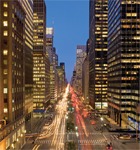It was back in 2004 when Anthony Westreich acquired 100 percent of the New York City-based Max Capital Management Corporation and its four-million-square-foot portfolio and established Monday Properties. Since that time, he has built his new firm into one committed to sound investment practices and uncompromising professional standards, focusing primarily on two of the world’s most competitive and lucrative real estate markets: New York City and the Washington, DC, metro area.

The view from 230 Park Avenue, Monday Properties's headquarters, is as iconic as the building itself. Originally built in 1929, the Manhattan landmark recently underwent a comprehensive renovation that earned the space LEED-EB Gold certification.
As executive vice president and COO, Brian Robin oversees all the company’s corporate and portfolio operations, including leasing, marketing, property management, and project development. “Our philosophy has been consistent from the beginning,” he says. “We are real estate people, and everyone who works here has always worked in real estate.” The company’s philosophy revolves around trying to perform better than anyone else in the industry and providing environments tenants can thrive in, “so they don’t have to think about real estate,” Robin adds.
Since 2002, Monday Properties has completed more than $8.5 billion in transactions, representing 18.9 million square feet throughout New York City and greater Washington, DC. The company manages each property in its portfolio and currently operates at 96 percent occupancy. Making this expansive portfolio more energy efficienct started with its own corporate headquarters: 230 Park Avenue. A designated Manhattan landmark, the pre-World War II building is one of the most visually recognizable in New York City. Monday Properties acquired the 34-story, 1.4-million-square-foot building in 2007, and recently the firm undertook a comprehensive renovation that earned the space LEED-EB Gold certification.
Extensive HVAC upgrades, steam-powered chillers, interior refurbishment, and energy-efficient upgrades on lighting all contributed to its Gold rating. “For the past 10 years, our focus has been to improve the asset,” says Hani Salama, senior vice president of property management and operations for the firm. “We did our best to improve the building performance as well as renovate the interior of the building—basically modernize the building from mechanical and electrical systems to aesthetics and space renovation. We spent approximately $100 million in 10 years, and all we had to do was invest another $250,000 to achieve LEED Gold certification, so it was really a modest step to complete the achievement.”
Salama says obtaining the LEED Gold rating was obviously a great thing for the company, but even more satisfying was showing other firms it could be achieved in an older structure. “We won BOMA-NY Operating Building of the Year for buildings over one million square feet, and we beat two very modern buildings,” Salama says. “Here’s this 1929 building that we were able to modernize and make it compete against any modern building in the city, and we are happy about that.” Next door is 237 Park Avenue, which was a large investment and another great success for the company—but in a much different way. “We first managed the building on a third-party basis,” Robin says. “We bought it in 2003 and in 2005 recapitalized it and in 2007 sold it. We transformed the nature of the investment through extensive leasing.”

Nearing completion, 1812 North Moore illustrates Monday Properties’s environmental commitment to new construction. The project anticipates LEED Platinum under the Core & Shell rating.
Other key projects along the way have concentrated on sustainability and the establishment of LEED-certified buildings in both markets. A prime example is 1812 North Moore Street, an increasingly esteemed, trophy-class office building in Rosslyn, Virginia, just across the Potomac River from Washington, DC. The project received LEED Gold certification for Neighborhood Development and expects Platinum under the Core & Shell rating upon completion in 2013. Designed by Davis Carter Scott, in collaboration with Gensler, one of the building’s most unique features is its well-planned floor plate. It might sound like a small detail, but the architects’ design makes each floor of 1812 North Moore Street—set to be the tallest office tower in the region—20 percent more efficient than a similarly sized structure. In addition, the building offers floor-to-ceiling glass, a virtually columnless interior layout, and a focus on indoor air quality.
The environmental elements at 1812 North Moore Street and elsewhere in Monday Properties’ portfolio are not tacked on for show. “Sustainability is fundamental as investors and fundamental as managers and operators in the same vein that smart engineering and efficiency are fundamental,” Robin says, explaining that Monday Properties is always asking how a space can operate better and more efficiently. “It’s different building by building. Sustainability on its own is desirable, but the real value is whether it rewards the investor buying and owning the building. We do believe that over time, just like smart engineering, it is universally appreciated.”
Robin says the company will continue to look for more opportunities with like-minded partners in its existing business sectors in New York and Washington, DC. “Our future plans include growth,” he says. “Geographically, we are very focused on markets we are in already and the partners we have, but we want to do what we are doing and want to do more of it and expect to do more of it. We like our identity as a partner to institutional investors and believe in New York City and the DC market.”

